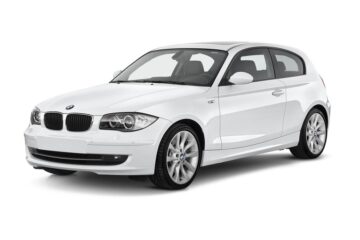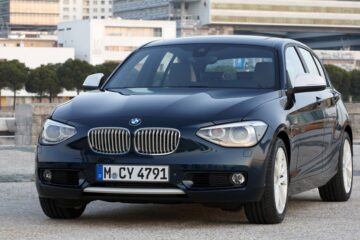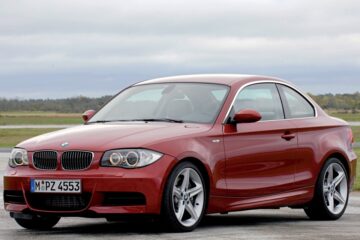Following the five-door model BMW F20, the BMW concern released a three-door hatchback F21. The public saw the car in 2012. Three years later, the BMW F21 underwent a restyling. We will not dwell on the exterior and interior of the car, because they are almost the same as the five-door model, BMW F20. There are some differences because of the equipment, and they are discussed below in the relevant section. Let’s briefly dwell on the powertrains.
Engines
Different motors are fitted to the F21 models.
Gasoline and diesel units N13 (116/118i), N47 (120d), N55 (M135i) are mounted on cars with an injector power system. Their volume varies in the range of 1.5-3.0 liters, power – in the range of 102-340 “horses”. Cars can reach a maximum speed of 195-250 km/h. and accelerate to a hundred in 4.8-11.2 sec. Fuel consumption is in the range of 4.3-10.3 liters /100 km.
The cars can reach a maximum speed of 185-240 km/h. and accelerate to a hundred in 6.3-12.2 seconds. Fuel consumption is in the range of 3.6-5.7 liters /100 km. Note that the engines with the index “B” appeared after restyling. All power units BMW F21 have a longitudinal arrangement and are equipped with TwinPower Turbo technology. Therefore, engine performance is increased and fuel consumption/CO2 emissions are reduced.
Electronics
The F21 is already equipped with a wide range of systems. Many of them are unique. Let us note some of them:
- High-Beam Assistant. The system allows you to switch from low beam to high beam and vice versa in auto mode. It optimizes headlight illumination to the maximum, increasing/decreasing illumination based on the specific traffic situation;
- Adaptive headlights to keep the light on when turning;
- Front camera and rear camera. They will bring a lot of usefulness when parking for motorists who have “no distance”. You can park even when there is minimal distance between neighboring cars. It is recommended to use in combination with the automatic parking assistant;
- LDWS. The system, using a camera mounted, most often in the interior mirror, warns the driver of a lane departure if the turn signal is not activated;
- Rear-end collision alarm;
- Automatic climate control;
- Cruise control, complete with brake function;
- SLI. Shows on the screen the authorized speed on a certain section of road if the driver misses this point;
- BMW Apps Ready has been developed for the iPhone 3GS/4/4/4S. It requires the installation of the “Apps” equipment.
The car is also equipped with rain sensors and automatic headlight sensors that turn on the wipers and lights when the required conditions occur. Comfort access system in F21 allows you to lock/unlock the car without actively using the identification transmitter. A good assistant for an inexperienced driver will be the gear shift indicator. It will indicate at which speed optimum economy will be achieved and at which speed it is desirable to shift to
A BMW Professional navigation system with hard disk drive will be required to quickly get to a specific locality and determine its location. The NBT multimedia system, which constantly updates the city map and traffic situation, is an excellent addition.
Features
All power units are combined with a 6-band manual as standard. But 8-speed Steptronic automatic transmission is an option. Also in the “base” buyers are offered ECO PRO mode, Auto Start Stop function, included in the modern system of brake energy recovery (BER), and EfficientDynamics technologies, combined with gearboxes. With its rear-wheel drive, unique suspension, optimal weight distribution and longitudinally mounted powertrain, the F21 hatchback offers excellent performance. And the optimization of the car’s rear axle and its front struts, makes this model the best in its class.
The base version features DSC (Dynamic Stability Control), DTC (Drive Traction Control) and ADB (Active Brake Differential) on the rear axle. An optional sport steering wheel and its drive-independent electromechanical power steering are available.
Equipment
BMW 1 Series F21 is available in different configurations. Three variants of BMW Line design are offered to buyers who have given preference to the “Bavarian”. The first configuration is sporty, Sport Line. Glossy finish of design elements is made in black color. It gives the hatchback a dynamic look. The business card of the car in this configuration is a shiny radiator grille, complete with 8 rails. The bumper has a center pillar, which looks like a diffuser in motorsports. The air intake liners stand out as well. The five-spoke R17 wheels have aluminum protrusions and are painted anthracite.
In the cabin, the sport seats and a similar leather multi-controller catch the eye, combining perfectly with the chrome console, round instruments and gray-red leather/black cloth upholstery. Such a combination suggests that the Line’s goal is dynamism.
The second configuration is a special one, Urban Line. The charisma of the three-door hatchback allows the car to stand out in the metropolis even in the mass of cars. One look at the double chrome grille with white ribs and its 11 partitions is enough to appreciate the appearance of BMW F21 116i. Completing the picture are the white/aluminum R16/17 wheels with V-spokes and polished protrusions. Modern color schemes with high-quality trim materials make up the interior of the Bavarian. The depth of innovation is created by square gauges with decorative trim made with strips of acrylic glass with a 3-dimensional effect. Blue/white lighting complements all this beauty.
The most popular package is the aerodynamic package, Sport Package. A lot of extra-sporty equipment awaits owners of such a car. They get M Sport Package, which includes light alloy disks R17 (R18 – optional) or M Aerodynamic, giving the car a sporty contour.
The side sills with bumpers have impressive dynamic shapes. The sporty direction of the hatchback is emphasized by a chrome exhaust pipe, a black radiator grille and a diffuser insert on the rear panel in a darkened metallic tone.
Sporty driving is possible thanks to the optional sport brakes and the adaptive M Sport suspension, which improves grip on paved roads. Body paint is available in 4 metallic colors and only one non-metallic color. The exclusive Estoril blue metallic color is available to buyers who have taken out the Sport M package.
Thanks to the adaptive suspension, a 10-millimeter decrease in ground clearance is created, which increases the hatchback’s maneuverability. In the settings of the car it is possible to set the driving mode to Sport or Comfort. But in any case, the car is guaranteed the utmost stability on the road surface. Sensors, regularly receiving information, will control the shock absorbers, based on the road surface and the situation on a particular stretch of road.
Traces of the M Sport package can also be seen in the interior of the F21:
- Sports seats upholstered in 6-way Alcantara fabric with contrast stitching in blue;
- The instrument panel dials are red-orange in color;
- Leather multi steering wheel with sporty design. It is pleasant, soft and comfortable to drive (the rim is covered with Nappa leather) and the steering wheel has a small radius.
Paddle shifters are provided for the automatic transmission, enabling quick gear changes. Dynamic driving and adaptive sports steering can therefore be enjoyed. For the MKPP, the gear lever cover with handbrake handle is designed in Nappa leather.
The availability of the package can also be judged by looking at the driving control functions. SPORT+ is added to them, and it has a Dynamic Stability Control mode. It will allow the driver, however, within certain limits, to control a drifting hatchback. Support the direction of sporty driving in the center console and additional knee pads with soft surfaces. By deflecting shocks, they create a comfortable environment when cornering.
Part of the package is aluminum hexagon strips with accent lines in blue. Sport seats are offered to consumers in the colors black, red (coral), and oyster. They have leather upholstery.
Difference between restyling and prerestyling
In 2015, the BMW 1 Series F20/F21 hatchback was updated. After restyling, the car has significantly changed in the engine compartment. The exterior of the car and its interior were slightly modified. A new design has acquired rear/front optics, bi-xenon headlights. Bumpers, air intakes, radiator grille, exhaust pipes have been updated. The quality of upholstery materials has been improved.
Generations and equipment
2 generation 09.2012 – 03.2014
| 116i MT Base | N13B16 | 1.6L | 136 hp |
| 116i AT Base | N13B16 | 1.6L | 136 hp |
| 118i MT Sport | N13B16 | 1.6L | 170 hp |
| 118i MT Urban | N13B16 | 1.6L | 170 hp |
| 118i AT Sport | N13B16 | 1.6L | 170 hp |
| 118i AT Urban | N13B16 | 1.6L | 170 hp |
| 120d MT xDrive Base | N47D20 | 2.0L | 184 hp |
| 120d MT Sport | N47D20 | 2.0L | 184 hp |
| 120d MT Urban | N47D20 | 2.0L | 184 hp |
| 120d MT Base | N47D20 | 2.0L | 184 hp |
| 120d AT Sport | N47D20 | 2.0L | 184 hp |
| 120d AT Urban | N47D20 | 2.0L | 184 hp |
| 120d AT Base | N47D20 | 2.0L | 184 hp |
| M 135i MT Base | N55B30 | 3.0L | 320 hp |
| M 135i AT xDrive Base | N55B30 | 3.0L | 320 hp |
| M 135i AT Base | N55B30 | 3.0L | 320 hp |



0 Comments